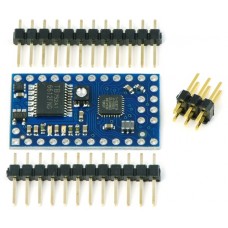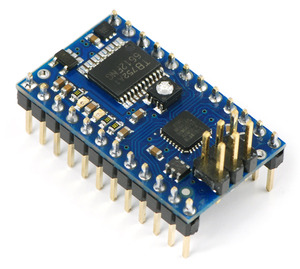Baby Orangutan B-328 Robot Controller
The Baby Orangutan is a complete control solution for small robots, all packed into a tiny 1.2" x 0.7" 24-pin DIP package. Its compact design eliminates bulkier components such as the LCD and switches while retaining the most essential features of the Orangutan robot controller line: a programmable ATmega48 or ATmega328P AVR microcontroller and a dual H-bridge for direct control of two DC motors. This integrated motor driver sets the Baby Orangutan B apart from similarly-sized microcontroller boards from other manufacturers. Two on-board indicator LEDs, a trimmer potentiometer, a 20 MHz resonator, and reverse battery protection round out the basic hardware features of the Baby Orangutan.
The removal of the larger Orangutan components also allows for a significantly improved manufacturing process that allows Pololu to offer the Baby Orangutan B at a very affordable price. Because the Orangutans are based on Atmel’s powerful AVR microcontrollers, the Orangutans deliver significantly higher performance than other similar controller boards. The availability of free development software, such as the Atmel StudioIDE and the WinAVR GCC C/C++ compiler, and low-cost programmers, such as the Pololu USB AVR programmer, make the Baby Orangutan B a truly outstanding value. We offer a combination deal that lets you save when you buy a USB AVR programmer with your Baby Orangutan.
For those not necessarily interested in robotics, the Baby Orangutan B is also a great introduction to the AVR microcontrollers because of its size and price. All you need to get started is a low-cost programmer and a power source. You can fit a substantial design even on a small breadboard since you won’t need the space for basic components such as the voltage regulator and resonator. The source code for several sample projects is available under our resources tab; these examples are intended to help you get up and running quickly with your new AVR-based controller.
Features
- overall unit dimensions: 1.2" x 0.7"
- input voltage: 5-13.5 V (15 V absolute maximum)
- two bidirectional motor ports can deliver ~1 A continuous (3 A peak) per channel
- programmable 20 MHz Atmel ATmega48 AVR microcontroller (4 KB flash, 512 bytes SRAM, 256 bytes EEPROM) or Atmel ATmega328P AVR microcontroller (32 KB flash, 2 KB RAM, 1 KB EEPROM)
- 18 user I/O lines, 16 of which can be used for digital I/O and 8 of which can be used as analog input channels
- 1 user LED
- user potentiometer tied to ADC7
- 20 MHz external resonator
- pinout is compatible with the Orangutan SV-328, Orangutan LV-168, and 3pi robot, so the same code will generally work on all of these devices
- comprehensive user’s guide
ATmega48, ATmega168, and ATmega328 comparison
The Baby Orangutan B is available with either the ATmega48 or ATmega328P AVR microcontroller (the ATmega168 version has been discontinued). The main differences between the mega48 and mega328P are memory size, boot loader support, and interrupt vector size. The mega328 can also run at lower voltages than the mega48 and mega168 for frequencies below 10 MHz.
| mega48 | mega168 | mega328P | |
|---|---|---|---|
| Flash | 4K Bytes | 16K Bytes | 32K Bytes |
| RAM | 512 Bytes | 1024 Bytes | 2048 Bytes |
| EEPROM | 256 Bytes | 512 Bytes | 1024 Bytes |
| Interrupt Vector Size | 1 instruction word/vector | 2 instruction words/vector | 2 instruction words/vector |
| Boot Loader Section | none | 128, 256, 512, or 1024words (256, 512, 1024, or 2048 bytes) |
256, 512, 1024, or 2048words (512, 1024, 2048, or 4096 bytes) |
Note: As of July 25, 2011, the Baby Orangutan B-48 is only available for high-volume orders. Please contact us if you are interested in placing such an order. The Baby Orangutan B-328 continues to be available as normal.
Included components
The compact module can be used as a DIP component on breadboards or prototyping boards, or the pin-less versions can be used for space-constrained installations in miniature robots. The 0.1" header pins are included with the Baby Orangutan B but are not soldered in. Power pins, one of the motor outputs, and several I/O lines are all accessible from one side to enable use of the Baby Orangutan as a single in-line pin (SIP) package for applications that do not require all of the I/O lines. The small size and low cost of the Baby Orangutan makes it a perfect option for primary control of small robots or for auxiliary control on larger robots.
|
|
Note: The Baby Orangutan B-168 has been replaced by the Baby Orangutan B-328, which uses the newer ATmega328P microcontroller to provide 32 KB of program memory, 2 KB of RAM, and 1 KB of EEPROM. The ATmega328P is essentially a drop-in replacement for the ATmega168, so the code that works on the Baby Orangutan B-168 should work with minimal modification on the Baby Orangutan B-328 (the Pololu AVR Librarynow supports the ATmega328P).
Enter the code in the box below:





-80x80.jpg)


-80x80.jpg)






